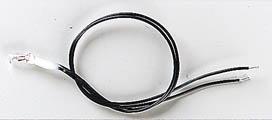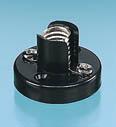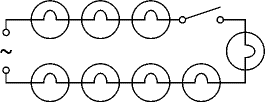Lamps 101

CIRCUIT SYMBOLS 101 | CONNECTORS 101 | CABLES 101 | LAMPS 101 | LEDS 101 | RELAYS 101 | SWITCHES 101
Lamps emit light when an electric current passes through them. All of the lamps shown on this page have a thin wire filament which becomes very hot and glows brightly when a current passes through it. The filament is made from a metal with a high melting point such as tungsten and it is usually wound into a small coil. Filament lamps have a shorter lifetime than most electronic components because eventually the filament 'blows' (melts) at a weak point.
There are two circuit symbols for a lamp, one for a lamp used to provide illumination and another for a lamp used as an indicator. Small lamps such as torch bulbs can be used for both purposes so either circuit symbol may used in simple educational circuits.
 |
 |
|
Lamp used for lighting |
Lamp used as an indicator |
There are three important features to consider when selecting a lamp:
-
Voltage rating - the supply voltage for normal brightness.
-
Power or current rating - small lamps are usually rated by current.
-
Lamp type - please see the table below.
The voltage and power (or current) ratings are usually printed or embossed on the body of a lamp.
Voltage rating
This is the supply voltage required for normal brightness. If a slightly higher voltage is used the lamp will be brighter but its lifetime will be shorter. With a lower supply voltage the lamp will be dimmer and its lifetime will be longer. The light from dim lamps has a yellow-orange colour.
Torch lamps pass a relatively large current and this significantly reduces the output voltage of the battery. Some voltage is used up inside the battery driving the large current through the small resistance of the battery itself (its 'internal resistance'). As a result the correct voltage rating for a torch lamp is lower than the normal voltage of the battery which lights it!
For example: a lamp rated 3.5V 0.3A is correct for a 4.5V battery (three 1.5V cells) because when the lamp is connected the voltage across the battery falls to about 3.5V.
Power or current rating
This is the power or current for the lamp when connected to its rated voltage. Low power lamps are usually rated by their current and high power lamps by their power. It is easy to convert between the two ratings:
|
P = I × V |
where: |
P = power in watts (W) |
Examples:
-
A lamp rated 3.5V 0.3A has a power rating P = I × V = 0.3 × 3.5 = 1.05W
-
A lamp rated 6V 0.06A has a power rating P = I × V = 0.06 × 6 = 0.36W
-
A lamp rated 12W 2.4W has a current rating I = P / V = 2.4 / 12 = 0.2A
|
Type of Lamp |
Example |
|||
|
MES Miniature Edison Screw LES Lilliput Edison Screw |
 |
|||
|
MCC Miniature Centre Contact |
 |
|||
|
SBC Small Bayonet Cap |
 |
|||
|
Pre-focus |
 |
|||
|
Wire ended |
 |
|||
|
Grain of Wheat |
 |
|||
|
|
|
|
||
|
|
|
|||
|
|
|
|||
 |
 |
|
screw terminals |
solder tags |
|
Lampholders |
|

Connecting and soldering
Lamps may be connected either way round in a circuit and the supply may be AC or DC.
Most lamps are designed to be used in a lampholder but the small 'wire ended' and 'grain of wheat' lamps have wires which may be soldered directly onto a circuit board.
Lampholders usually have screw terminals or solder tags to attach wires. Some small holders have contacts which may be soldered directly to a circuit board.
Lamps in Series
Several lamps can be successfully connected in series provided they all have identical voltage and power (or current) ratings. The supply voltage is divided equally between identical lamps so their voltage rating must be suitable for this. For example Christmas tree lights may have 20 lamps connected in series to a 240V supply, so each lamp will have 240V ÷ 20 = 12V across it.
A disadvantage of connecting lamps in series is that if one lamp blows all of them will go out because the circuit is broken. Christmas tree lamps have a special feature to overcome this problem; they are designed to short circuit (conduct like a wire link) when they blow, so the circuit is not broken and the other lamps remain lit, making it easier to locate the faulty lamp. Sets also include one 'fuse' lamp which blows normally.
WARNING! The Christmas tree lamps may seem safe because they use only 12V but they are connected to the mains supply which can be lethal. Always unplug from the mains before changing lamps. The voltage across the holder of a missing lamp is the full 240V of the mains supply! (Yes, it really is!)
![]()
![]()
![]()
![]()
